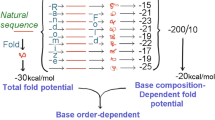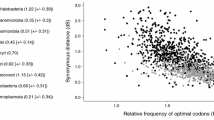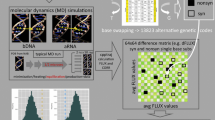Abstract
When there are no biases in mutation and selection between the two strands of DNA, the 12 possible substitution rates of the four nucleotides reduces to six (type 1 parity rule or PR1), and the intrastrand average base composition is expected to be A = T and G = C at equilibrium without regard to the G + C content of DNA (type 2 parity rule or PR2). Significant deviations from the parity rules in the third codon letters of the four-codon amino acids result mostly from selective biases rather than mutational biases between the two strands of DNA during evolution. The parity rules lay the foundation for evaluating the biases in synonymous codon usage in terms of (1) directional mutation pressure for variation of the DNA G + C content due to mutational biases between α-bases (A or T) and γ-bases (G or C), (2) strand-bias mutation, for example, by DNA repair during transcription, and (3) functional selection in evolution, for example, due to tRNA abundance. The present analysis shows that, although the PR2 violation is common in the third codon letters of four-codon amino acids, the contribution of PR2 violation to the DNA G + C content of the third codon position is small and, in majority of cases, mildly counteracts the effect of the directional mutation pressure on the G + C content.
Similar content being viewed by others
References
Bennetzen JL, Hall B (1982) Codon selection in yeast. J Biol Chem 257:3026–3031
Bernard G, Olfsson B, Filipski J, Zerial M, Salinas J, Cuny G, MeunierRotival M, Rodier F (1985) The mosaic genome of warm-blooded vertebrates. Science 228:953–958
Bohr VA, Smith CA, Okumoto D, Hanawalt PC (1985) DNA repair in an active gene: removal of pyrimidine dimers from the DHFR gene of CHO cells is much more efficient than in the overall genome. Cell 40:359–369
Brinkmann H, Martinez P, Quigley F, Martin W, Cerff R (1987) Endosymbiontic origin and codon bias of the nuclear gene for chloroplast glyceraldehyde-3-phosphate dehydrogenase from maize. J Mol Evol 26:320–328
Campbell WH, Gowri G (1990) Codon usage in higher plants, green algae, and cyanobacteria. Plant Physiol 92:1–11
Chevallier A, Garel JP (1979) Studies on t-RNA adaptation, t-RNA turnover, precursor t-RNA and t-RNA gene distribution in Bombix mori using two-dimensional polyacrylamide gel electrophoresis. Biochemie 61:245–262
Cox EC, Yanofsky C (1967) Altered base ratios in the DNA of an Escherichia coli mutator strain. Proc Natl Acad Sci USA 58:1895–1902
Evans MK, Taffe BG, Harris CC, Bohr VA (1993) DNA strand bias in the repair of the p53 gene in normal human and xeroderma pigmentosum group C fibroblasts. Cancer Res 53:5377–5381
Freese E (1962) On evolution of base composition of DNA. J Theor Biol 3:82–101
Gardiner-Garden M, Frommer M (1992) Significant GC-rich regions in angiosperm genes. J Mol Evol 14:231–245
Gouy M, Gautier C (1982) Codon usage in bacteria: correlation with gene expressivity. Nucleic Acids Res 10:7055–7074
Grantham R, Gautier C, Mercier R, Pave A (1980) Codon catalog usage and the genome hypothesis. Nucleic Acids Res 8:r49-r62
Grosjean H, Fiers W (1982) Preferential codon usage in prokaryotic genes: the optimal codon-anticodon interaction energy and the selective codon usage in efficiently expressed genes. Gene 18:199–209
Ikemura T (1981a) Correlation between the abundance of Escherichia coli transfer RNAs and the occurrence of the respective codons in its protein genes. J Mol Biol 146:1–21
Ikemura T (1981b) Correlation between the abundance of E. coli t-RNA and the occurrence of the respective codons in its protein genes: a proposal for a synonymous codon choice that is optimal for the E. coli translational system. J Mol Biol 151:389–404
Jansson S, Meyer-Gauen G, Cerff R, Martin W (1994) Nucleotide distribution in gymnosperm nuclear sequence suggests a model for GC-content change in land-plant nuclear genomes. J Mol Evol 39:34–46
Jukes TH, Osawa S, Muto A (1987) Divergence and directional mutation pressures. Nature 325:668
Karkas JD, Rudner R, Chargaff E (1968) Separation of B. subtilis DNA into complementary strands. 11. Template functions and composition as determined by transcription with RNA polymerase. Proc Natl Acad Sci USA 60:915–920
Lobry JR (1995) Properties of a general model of DNA evolution under no-strand bias conditions. J Mol Evol 40:326–330
Muto A, Osawa S (1987) The guanine and cytosine content of genomic DNA and bacterial evolution. Proc Natl Acad Sci USA 84:1166–1169
Prabhu VV (1993) Symmetry observations in long nucleotide sequences. Nucleic Acids Res 21:2797–2800
Rudner R, Karkas JD, Chargaff E (1968) Separation of B. subtilis DNA into complementary strands, III. Direct analysis. Proc Natl Acad Sci USA 60:921–922
Schaeffer L, Roy R, Humbert S, Moncollin V, Vermeulen W, Hoeijmakers JH, Chambon P, Egly JM (1993) DNA repair helicase: a component of BTF2 (TFIIH) basic transcription factor. Science 260:58–63
Sharp PM, Li W-H (1986) An evolutionary perspective on synonymous codon usage in unicellular organisms. J Mol Evol 24:28–38
Sharp PM, Li W-H (1989) On the rate of DNA sequence evolution in Drosophila. J Mol Evol 28:398–402
Shields DC, Sharp PM, Higgins DG, Right F (1988) Silent sites in Drosophila genes are not neutral: evidence of selection among synonymous codons. Mol Biol Evol 5:704–716
Sueoka N (1962) On the genetic basis of variation and heterogeneity of DNA base composition. Proc Natl Sci USA 48:582–592
Sueoka N (1988) Directional mutation pressure and neutral molecular evolution. Proc Natl Acad Sci USA 85:2653–2657
Sueoka N (1992) Directional mutation pressure, selective constraints, and genetic equilibria. J Mol Evol 34:95–114
Watson JD, Crick FHC (1953) A structure for deoxyribose nucleic acid. Nature 171:737–738
Author information
Authors and Affiliations
Rights and permissions
About this article
Cite this article
Sueoka, N. Intrastrand parity rules of DNA base composition and usage biases of synonymous codons. J Mol Evol 40, 318–325 (1995). https://doi.org/10.1007/BF00163236
Received:
Issue Date:
DOI: https://doi.org/10.1007/BF00163236




